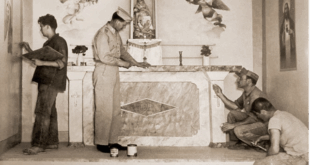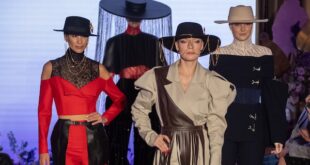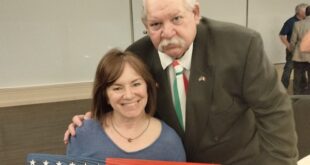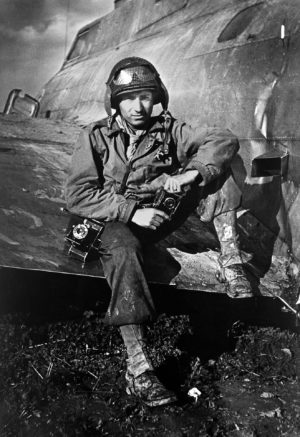
Too young to join the Signal Corps, Tony Vaccaro defied his superiors and spirited a $47 camera into the teeth of battle, taking some of the most gripping photos of World War II while charting the course of his professional life.
Huddled alongside his fellow infantrymen in a transport speeding across the English Channel, Private First Class Tony Vaccaro didn’t know he was headed to Omaha Beach on June 18, 1944, a little more than a week after the D-Day invasion had commenced.
Before boarding the ship, Vaccaro’s superiors sternly warned the American soldiers that anyone caught taking pictures would have their cameras confiscated and destroyed.
Armed with an M1 rifle, an Argus C3 camera he purchased for $47.50 a few years earlier and a burgeoning passion for photography, the 21-year-old Vaccaro stealthily maneuvered his camera beneath his raincoat to see if he could snap a photo through the buttonhole. The Argus was a light, consumer-grade camera with a durable plastic lens, but Vaccaro was unable to take a satisfying picture, so he used his hands to widen the raincoat’s buttonhole to capture the sight of nearly a dozen Allied ships in the waters outside of France.
“The first day that I arrived at Normandy, I felt that anything I would experience should be recorded with a camera,” said Vaccaro, whose life and wartime exploits are the focus of the award-winning documentary “Underfire: The Untold Story of Pfc. Tony Vaccaro,” which debuted in 2016 and is now available on all of HBO’s on-demand and streaming platforms as well as iTunes and Amazon.
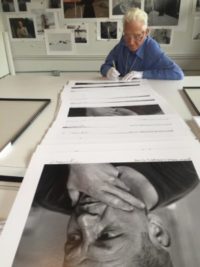
Vaccaro dubbed that rain-drenched image “my first view of libéré France,” and it was the first of a flood of shots the Italian-American G.I. took in the crucible of World War II. Over the next 272 days of combat, Vaccaro snapped approximately 8,000 photographs of the war as the 83rd Infantry Division fought its way across France toward Germany and ultimately right into Berlin.
The photos remained locked away by Vaccaro for nearly 50 years before he had enough emotional distance from the war to share them with the public. Now one of the world’s preeminent commercial, fashion and magazine photographers — an artist who captured intimate portraits of John F. Kennedy, Sophia Loren, Pablo Picasso and Georgia O’Keefe in the intervening years — Vaccaro began telling his unique story and exhibiting the photos he risked his life to capture.
“I was fortunate that I didn’t get killed somewhere at some point,” Vaccaro, now 95 years old, says. “I survived Normandy. I survived the Elbe River. I was very lucky, and luck has played a tremendous part in my life.”

Born Michelantonio Celestino Onofrio Vaccaro in Greensburg, Penn., Vaccaro spent much of the first few years of his life between America and Bonefro, Italy. Orphaned at age 5, Vaccaro was sent to live with a physically abusive uncle and work on a farm in Italy while his sisters were sent to an orphanage. “When you’re an orphan, this world is ugly,” Vaccaro says.
By 1939, with fascism on the rise throughout the country, Vaccaro left Italy and returned to America to finish his schooling in New Rochelle, N.Y. Following his high school graduation, Vaccaro was drafted into the Army. Already a talented amateur photographer, he unsuccessfully lobbied an Army Signal Corps captain to allow him to become an official combat photographer. While the commanding officer was impressed with Vaccaro’s portfolio, he deemed him too young for the post. Undaunted, Vaccaro vowed to take his camera with him overseas and made a bold proclamation: “I am going to show you that I can do better than all the Signal Corps photographers put together,” he said.
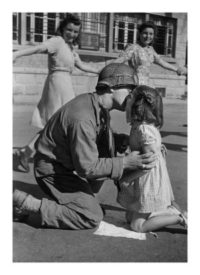
A common refrain throughout “Underfire,” which features interviews with modern-era conflict photographers who hail Vaccaro as an unsung hero, is how much closer Vaccaro got to the action than any authorized Army photographer. In fact, no photographer on record from that era got as close to combat as he did.
“Tony thought he could be a photographer and he in fact became one by learning how to deal with the horrors of war,” says the film’s director, Max Lewkowicz.
Vaccaro quickly proved to his fellow soldiers that he was going to fight alongside them first and photograph second, earning their trust and admiration. “He was always a soldier,” Lewkowicz says. “It was always a very fine line.”
Unencumbered by the larger cameras carried by official military photographers, Vaccaro embraced his surroundings and worked around an environment with scant resources. Using his raincoat as a tarp, he would develop his negatives right in the foxholes, filling helmets with photographic chemicals he scavenged from abandoned stores along his march.
Despite the technical limitations, Vaccaro’s wartime photo collection paints a fully realized portrait of the fighting through the eyes of a man who defied death by sniper fire, tanks, machine gun nests and a harrowing shelling in Germany’s Hürtgen Forest. There are photos of the aftermath of brutal fighting, and Vaccaro somehow even captured the tragic death of Pvt. Jack Rose, whose body appears to have gone lifeless the moment the shutter opened. But there are also portraits of his fellow soldiers and pictures of other less harrowing moments, including a close-up look at a speech given by Gen. George S. Patton to the troops; and celebratory images as the war finally drew to a close.
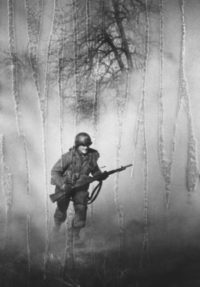
“The fact that I survived I felt as if someone was behind me,” Vaccaro says. “I’m fortunate that I was one of the few photographers that survived the war.”
Much of “Underfire” plays as a travelogue as Lewkowicz takes Vaccaro back to Europe where the photographer, who still carries a camera around his neck whenever he’s out and about, recounts his experiences and explores the places he fought at and photographed seven decades ago.
“I wanted to tell a story about someone from the Greatest Generation who was remarkable and an amazing photographer,” Lewkowicz says of his subject. “Tony has the capability of using that medium and being able to express himself so beautifully.”
Looking at it decades later, it seems inevitable that the war would transform Tony Vaccaro and set him on a career path that eventually took him to some of Earth’s most beautiful places to photograph some of its most fascinating people. What he witnessed and what he recorded through the lens of a $47 camera in the worst of World War II not only stands as a testimony to his heroism under fire, but to the power of art to take us away from the darkness and into the light.
“I experienced war and that gave me that idea that war is horrible and it moved me toward beauty for the rest of my life,” Vaccaro says.
Examples of Vaccaro’s incredible wartime and commercial photography are available to browse at www.tonyvaccaro.studio and www.tonyvaccarofilm.com.
The above appeared in the May issue of the print version of Fra Noi. Our gorgeous, monthly magazine contains a veritable feast of news and views, profiles and features, entertainment and culture. To subscribe, click here.
 Fra Noi Embrace Your Inner Italian
Fra Noi Embrace Your Inner Italian


